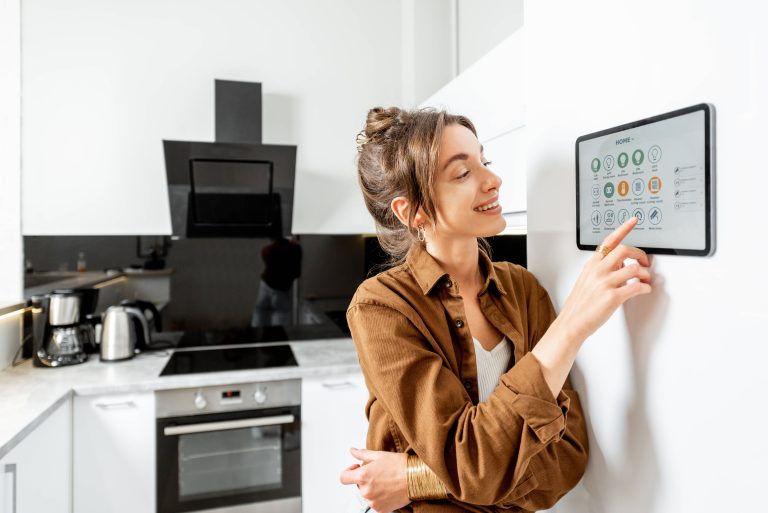
In the ever-evolving landscape of technology, robotics has emerged as a transformative force, particularly in the realm of smart homes. Gone are the days when robots were mere figments of sci-fi imaginations or confined to industrial uses. Today, the advent of robots in domestic spaces signifies a paradigm shift in how we perceive and interact with our living environments. From automated vacuum cleaners to sophisticated personal assistants, robotics is shaping the future of smart homes in ways we could only dream of a decade ago.
The Rise of Domestic Robots
The integration of robotics into smart homes is not a sudden leap but the result of meticulous advancements over the years. It all began with simple automated tools designed for convenience. Robotic vacuum cleaners like Roomba were among the first to penetrate the consumer market, offering a glimpse of what automation in daily chores could mean. These initial forays laid the groundwork for more complex and multifunctional robotic systems that promise to revolutionize home living.
Enhanced Home Security
One of the most significant contributions of robotics to smart homes is in the domain of home security. Modern smart homes are increasingly equipped with robotic security systems capable of real-time surveillance, threat detection, and emergency responses. These robots are often integrated with advanced AI algorithms and sensors that provide 360-degree surveillance, facial recognition, and even intruder deterrence mechanisms.
For instance, robotic security systems like Knightscope’s K5 can patrol the premises, detect unusual activities, and alert homeowners or authorities as needed. More than just passive guardians, these robots actively engage with their environment to ensure a heightened level of security.
Personalized Assistance
Personal assistant robots have taken the concept of smart living to a whole new level. Unlike traditional AI assistants like Alexa or Google Home, these robots possess physical mobility and can traverse the living space to perform tasks. Imagine a robot that not only turns on your lights or plays your favorite song but also brings you a glass of water, reminds you to take your medication, or helps you find your misplaced keys.
Robots such as Temi and Aido are at the forefront of this revolution. They are designed to understand and respond to natural language commands, can recognize faces, and learn from user interactions to deliver highly personalized services. These assistant robots cater to the unique needs and preferences of each family member, creating a truly customized and convenient home experience.
Smart Cleaning Solutions
While robotic vacuum cleaners have been around for a while, the latest iterations are far more advanced, tackling various cleaning tasks with precision and efficiency. Modern robotic cleaners come equipped with intelligent mapping systems, allowing them to navigate complex layouts without missing spots or falling down stairs. They can adjust their cleaning modes based on surface types and the level of dirt detected.
Beyond vacuuming, there are robotic mops that can scrub and sanitize floors, robotic window cleaners that tackle hard-to-reach areas, and even robots designed to clean swimming pools. Companies like iRobot and Ecovacs have developed products that boast self-emptying dustbins, automated scheduling, and integration with other smart home devices, ensuring that your home remains spotless with minimal intervention.
Elderly and Healthcare Assistance
Robotics in smart homes holds immense potential in the healthcare sector, particularly for elderly care. With the aging population rising, there is a growing demand for solutions that allow seniors to live independently and safely. Robots designed for elderly care can assist with daily activities, monitor health conditions, and provide companionship, significantly improving the quality of life for older adults.
Robots such as ElliQ and Buddy are designed to offer emotional support, remind users to take their medications, help them stay connected with family and friends, and even assist with physical exercises. These robots act as both caregivers and companions, addressing the physical and emotional needs of the elderly.
Entertainment and Socialization
The role of robots in smart homes is not limited to practical functions; they also enhance the entertainment and socialization aspects of home life. Robots like Miko and Vector can engage with children, helping them learn through interactive play, storytelling, and educational games. These robots adapt to a child’s learning pace, providing a personalized educational experience that traditional toys or devices cannot match.
For adults, robots can serve as social companions, capable of engaging in conversations, recognizing moods, and providing entertainment. Whether it’s playing music, controlling smart home devices, or offering stimulating quizzes, robotic companions add a new dimension to home entertainment.
The Future of Robotics in Smart Homes
As we look towards the future, the role of robotics in smart homes is set to expand even further. Advances in artificial intelligence, machine learning, and sensor technologies will lead to the development of even more sophisticated and capable robots. We can anticipate a future where robots seamlessly integrate into our daily lives, performing tasks autonomously, anticipating our needs, and enhancing our overall living experience.
The potential applications are vast and varied. From robotic chefs that prepare gourmet meals to robots that manage home energy consumption and sustainability, the possibilities are limited only by our imagination. The smart home of the future will be a dynamic, responsive environment, with robots acting as the cornerstone of this intelligent ecosystem.
Conclusion
Robotics is undeniably transforming smart homes, combining convenience, efficiency, and personalization to create living spaces that cater to our every need. The advancements in this field are not just about luxury but also about enhancing the quality of life, ensuring security, and providing invaluable assistance to those who need it most. As technology continues to evolve, we stand on the cusp of a new era in home automation, where robotics will play a pivotal role in shaping our domestic landscapes. Embrace the future of smart living, where the boundaries between science fiction and reality blur, and robots become an integral part of our everyday lives.







